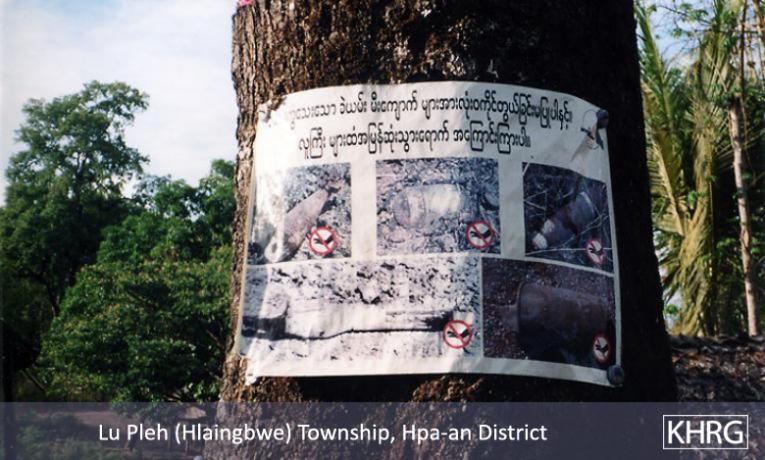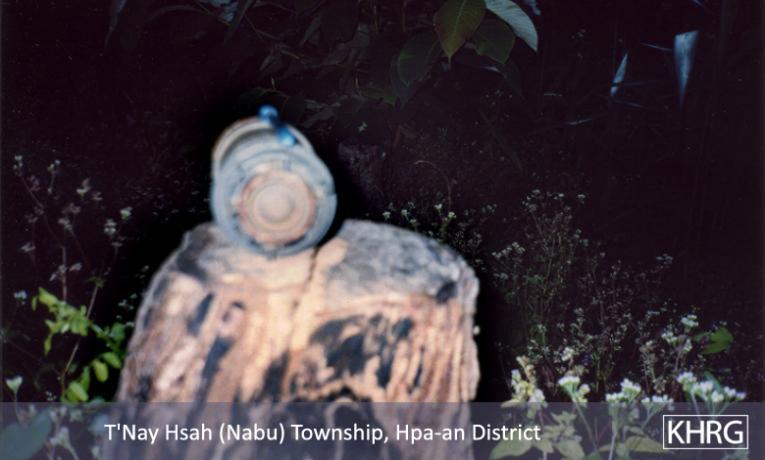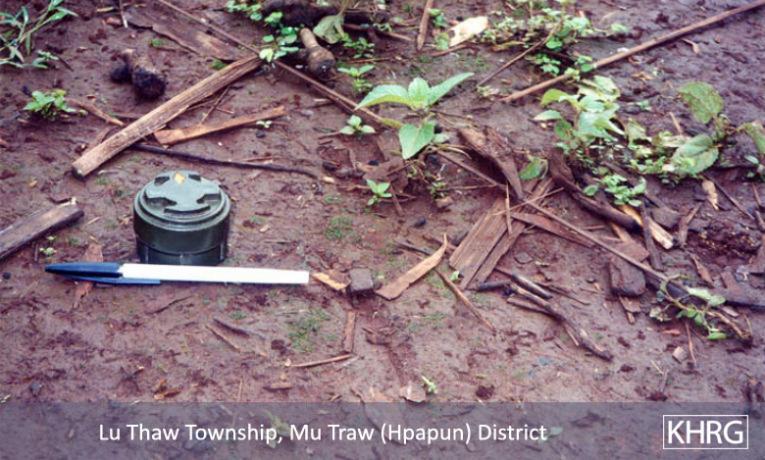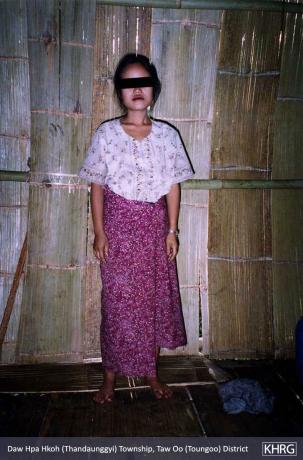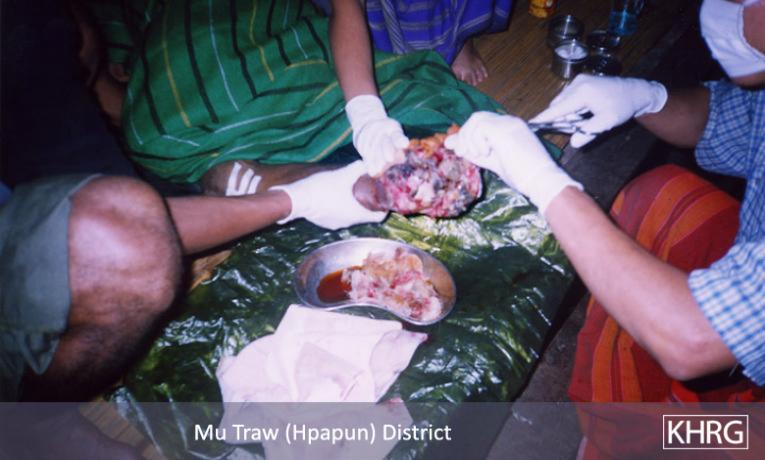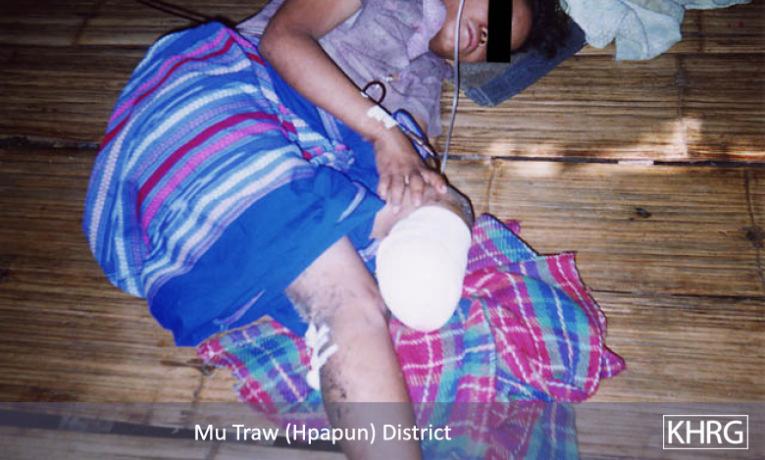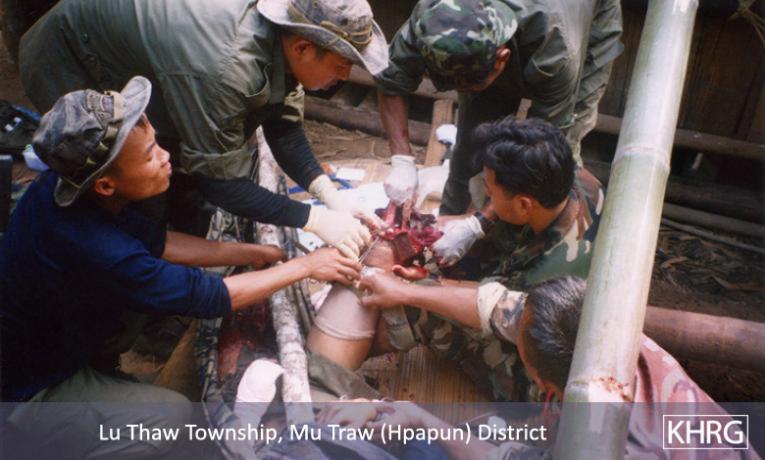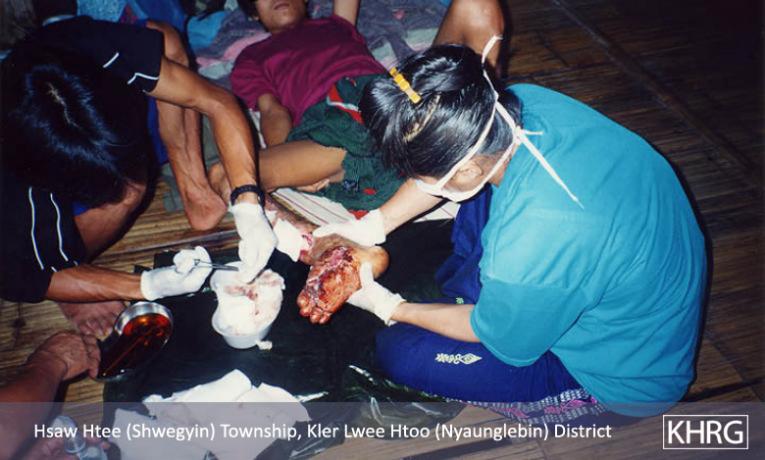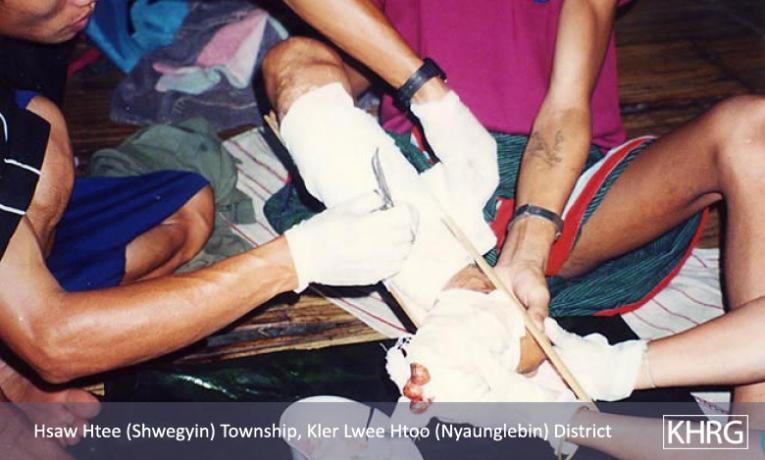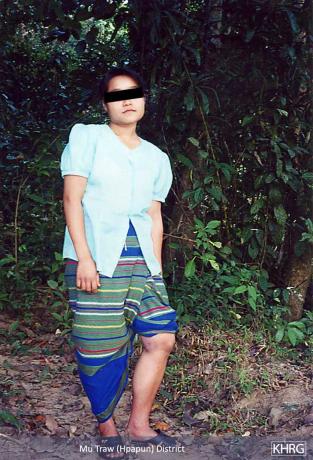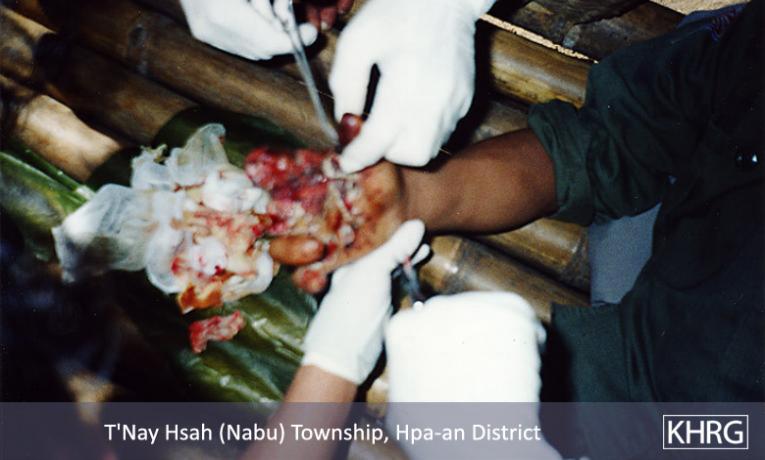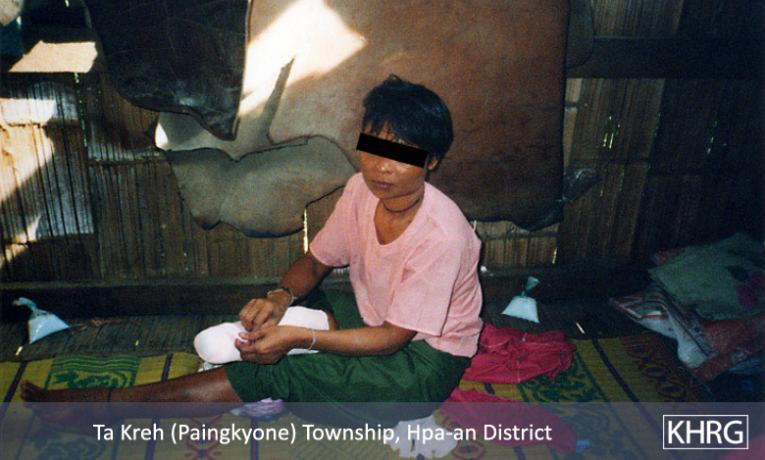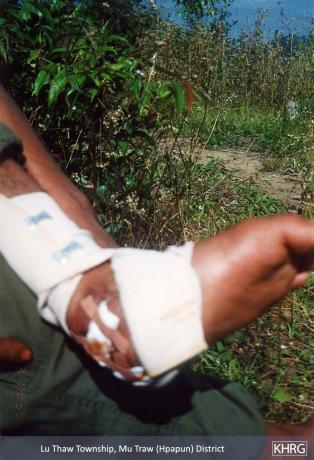From October 2004 through January 2005, SPDC forces based in the plains of western Nyaunglebin district made forays eastward up the rivers into the hills in an effort to flush out the hill villagers who have thus far evaded their control. The timing deliberately coincided with the annual rice harvest, and the tactics were simple: seek out the villagers' fields, burn or scatter the harvested grain, destroy the crop still in the fields by trampling or landmining it, or let animals and insects destroy it once the villagers have fled. Burn the rice storage barns, the houses, schools and churches, and shoot the villagers on sight. Make life in the hills untenable, so that villagers have to come and live under SPDC control.
From October 2004 through January 2005, SPDC forces based in the plains of western Nyaunglebin district made forays eastward up the rivers into the hills in an effort to flush out the hill villagers who have thus far evaded their control. The timing deliberately coincided with the annual rice harvest, and the tactics were simple: seek out the villagers' fields, burn or scatter the harvested grain, destroy the crop still in the fields by trampling or landmining it, or let animals and insects destroy it once the villagers have fled. Burn the rice storage barns, the houses, schools and churches, and shoot the villagers on sight. Make life in the hills untenable, so that villagers have to come and live under SPDC control.
Landmines are used extensively by SPDC, DKBA, and KNLA forces in Karen regions. The SPDC has not ratified the 1997 International Convention on the Prohibition of the Use, Stockpiling, Production, and Transfer of Antipersonnel Mines and On Their Destruction (commonly referred to as the "Mine Ban Treaty"), and the DKBA and KNLA cannot ratify it because they are non-state groups. While the use of mines has been increasingly condemned and curtailed globally since 1997, their use by all parties has steadily increased in Karen State during the same period. The 2002 report "Impact of Landmines in Burma" released by Nonviolence International claimed that there had been a slight but steady increase in mine incidents throughout Burma since 1995, reaching an estimated 1,500 landmine victims per year. Landmine use has continued unabated since then, and the 2004 "Landmine Monitor" released by the International Campaign to Ban Landmines states that "there are some indications of increased mine warfare" and that "Myanmar is among the countries with the highest number of [mine] casualties each year." [1] The SPDC manufactures large numbers of several types of mines in its principle mine factory in Meiktila and associated explosives factories throughout central Burma, while the KNLA and DKBA continue to improvise their own rudimentary mines. None of these groups effectively map their mines or remove them when no longer wanted. The SPDC and DKBA only inform villagers which areas are mined if it serves their strategic intent, which is seldom. The KNLA tries to inform villagers, but only sporadically and often insufficiently.
Most of those wounded, killed and otherwise affected by these mines are civilians. This is not unusual for mine-infested countries, where mines targetted at combatants are more likely to unintentionally kill and maim civilians. However, in Burma the SPDC often deploys mines with the intention of killing and maiming civilians. SPDC troops trying to force villagers into SPDC-controlled areas deliberately landmine their villages, food storage sites, farmfields and pathways to make it impossible to live in remote areas. The deliberate intention is to maim and kill a few displaced villagers in the hope that this will encourage the rest to come out of hiding. In addition, civilians taken as porters by SPDC units are frequently forced to walk in front of the troops as human minesweepers, or to walk alone along pathways where mines are suspected. To discourage the KNLA from mining roads, SPDC units sometimes force villagers to drive their bullock carts or ride in the back of trucks along roads before important military convoys are to pass. Villagers are forced to clear the ground alongside roads to make mining them more difficult, and sometimes step on mines while doing so. When KNLA mines wound SPDC soldiers or destroy their vehicles, brutal retaliation is carried out against Karen civilians living in the area.
Many landmine victims die on the spot or before they can be carried to help, which may be several days away. The limited medical help available, usually from KNLA medics or mobile medical teams, is usually limited to amputation without anaesthesia. Mines not only cause death and loss of limbs, but also force villagers to abandon their villages and fields, and undermine their survival by restricting their movements and livelihood activities.
The photos below have been divided into two categories: The Mines , showing some of the types of anti-personnel landmines being used in Karen areas and how they are used, and The Victims , showing the direct and indirect effects that these landmines have on villagers. Additional information and background on mine use in Karen areas can be found in most major KHRG reports and in past KHRG Photo Sets.
11.1 The Mines
The SPDC Army, DKBA and KNLA all use mines throughout Karen regions. Traditionally the Tatmadaw used mines mainly around its camp perimeters and it still does so, but in recent years SPDC soldiers have greatly increased their use of landmines. They now use them to restrict the movement of villagers (see photo 11-2 ) and to undermine the survival of IDPs, by laying mines in villages and farmfields in areas which they are trying to depopulate (see photos 1-27 and 2-15 to 2-17 ), booby-trapping rice storage barns (see photos 11-20 to 11-24 ), and mining pathways known to be used by displaced villagers (see photos 11-1 and 11-2 ). The DKBA lays mines in similar locations, though their targets are often KNLA soldiers rather than civilians. The KNLA, with far too few troops to meet SPDC forces head-on, uses mines to harass and restrict the movement of SPDC columns and to protect KNLA supply lines. This includes laying mines along the roads and pathways used by SPDC columns, and in the jungle just off pathways used as KNLA supply lines in order to prevent SPDC troops from setting up ambushes. None of these forces properly map their mines, and they almost never remove them even when their supposed 'strategic' use has passed. All three groups also use Claymore directional mines (see below), mainly for springing ambushes but sometimes rigged to tripwires. The KNLA clears large numbers of SPDC mines, including most of those shown below (see photos 2-15 to 2-17 , 11-4 and 11-5 , 11-8 , and 11-9 and 11-10 ), and presumably the SPDC and DKBA clear KNLA mines when found. Villagers sometimes clear mines themselves if no KNLA soldiers are available; photo 11-3 shows a poster warning them against the dangers of this, smuggled in from Thailand as part of Nonviolence International's mine awareness campaign in Karen areas.
The SPDC's increased use of mines has been facilitated by the establishment of a domestic mine production capability. Until the late 1980s the regime relied mainly on imported Chinese and American-made landmines, but in the early 1990s the Chinese government provided the SPDC with a custom-built factory dedicated to the manufacture of landmines at Meiktila in Central Burma. This works in conjunction with high explosives factories, some of which are in Prome and Magwe, established in the late 1960s under the BSPP regime. Collectively known as the Ka Pa Sa factories [abbreviated from Karkweye Pyitsu Setyoun – the Burmese name for the Directorate of Defence Industries] , these are known to produce at least two types of landmines: the MM-1 and the MM-2, labelled in Burmese 'Ma Ma 1' and 'Ma Ma 2' (the 'Ma Ma' may stand for Myanma Mine-bon [Myanmar Mine]). The MM-1 is a copy of the Chinese-made Type 58 Stake Fragmentation Mine (SFM), itself a copy of the Soviet PMOZ-2 or 'corncob' mine (see Photo 11-1 ). This mine is either buried with just the detonator above ground, or mounted above ground on a stake, usually concealed among long grass or bushes, with a tripwire attached. The latter method makes it more likely to kill the victim outright rather than just blow off the leg, and allows it to kill or maim not only the person who triggers it but others within a radius of a few metres. Upon detonation, the cast iron body of the mine shatters into 60 pre-shaped segments which are thrown outwards in a 360 degree arc. The MM-2 is a copy of the Chinese-made Type 58 Blast Mine (BM), which is itself a copy of the older Soviet PMN mine (see Photo 11-8 ). It is buried so that the pressure plate that forms its upper surface is level with the ground. Its explosive force is sufficient to completely blow off a person's lower leg. KNLA soldiers have also unearthed many American M-14 (or copy) mines laid by SPDC troops (see photos 1-27 and 11-9 and 11-10 ). Lower powered than the MM2, these small mines are concealed in the ground and maim the leg of whoever triggers them. The SPDC also manufactures its own variant of the American-made M-18 Claymore Directional Fragmentation Mine (DFM). These mines are normally command detonated electrically using a hand dynamo in order to spring an ambush, but may also be rigged to detonate with a tripwire. When the mine is detonated, the C4 explosive which constitutes just under half the mine's weight explodes, sending 700 small steel balls out in a 60 degree arc with a stated lethal range of up to 50 metres. Anything caught within this lethal arc is literally cut to shreds. Recent evidence indicates that the SPDC may now also be producing its own bounding fragmentation mines (BFM) (See photos 11-4 and 11-5 ). These are buried but when triggered they spring into the air before exploding, so they are more likely to kill their victims as well as anyone else within several metres.
Most of the KNLA's landmines are homemade Improvised Explosive Devices (IEDs), typically consisting of a length of plastic piping stuffed with gunpowder or explosives and scrap metal or shotgun pellets, attached to a small detonator powered by a cheap dry cell alkaline battery (examples of KNLA IEDs are shown in photos F13 and F17 in Photo Set 2002-A). They make different versions of these, including high-powered ones sufficient to destroy a truck when concealed along vehicle roads. They also have some American-made landmines and claymores bought on the Thai black market, and mines captured from SPDC forces.
The DKBA is capable of producing landmines similar to those used by the KNLA. The SPDC has also supplied the DKBA with mines on occasion, though it is unclear to what extent and whether this is still occurring. The DKBA now appears to have developed the capability to manufacture its own Claymore mines (see photos 11-6 and 11-7 ).
11.2 The Victims
The majority of people wounded and killed by landmines in Karen regions are civilians. Not only is the use of landmines out of all proportion to the low-level nature of the armed conflict, but the SPDC in particular and the DKBA to a lesser extent are deploying landmines specifically targetted at displaced civilian populations. In areas which the SPDC is trying to depopulate, abandoned villages are mined to prevent people living there (see photos 11-11 , 3-3 , 11-47 and 2-15 to 2-17 ); fields and riverbanks are mined to block their access to food (see photos 11-16 to 11-18 , 11-29 to 11-31 , and 11-50 ); rice storage barns are booby-trapped (see photos 11-20 to 11-24 ); and pathways are mined to restrict villagers' movements (see photos 10-85 to 10-87 ), to stop relocated villagers from returning home (see photos 11-16 to 11-18 , 3-3 , and 10-57 to 10-58 ), and to prevent supplies reaching IDPs in hiding from SPDC-controlled areas (see photos 11-1 and 11-2 ). In addition, villagers are routinely used as human minesweepers by SPDC forces. Civilian and convict porters are forced to march in front of SPDC columns (see photos 6-79 , 6-80 and 6-81 , and 6-93 ), or ordered to walk along a potentially mined path while the soldiers move through the bush (see photos 11-37 to 11-39 ). Porters or guides who step on mines are usually left to die in the forest (see photo 11-45 ), while SPDC soldiers wounded by mines are carried (by forced labour civilian porters) to medical help. Convict porters sometimes trigger landmines when they flee through the forest (see photos 11-27 and 11-28 and 11-40 and 11-41 ). People doing forced labour clearing roadsides or gathering materials for SPDC officers sometimes detonate landmines as well (see photos 6-105 and 6-106 and 11-51 ), but are given no compensation for medical costs. Children are frequent victims, whether during forced labour or while helping gather food for their families (see photos 11-19 , 11-25 and 11-26 , 11-32 to 11-36 , and 11-50 ). Villagers also lose significant numbers of livestock to mines (see photos 10-85 to 10-87 and 11-53 ).
SPDC and DKBA forces only inform villagers where mines have been placed if their purpose is to keep villagers out of those areas – in which case they sometimes warn of landmines which do not exist. The KNLA regularly informs village elders and IDP leaders of which pathways and areas are mined, but these efforts are not systematic and villagers often fall victim to KNLA mines. Soldiers of all sides are wounded or killed while trying to lay their own mines or clear those laid by the other armies (see photos 11-42 and 11-43 ). Some displaced villagers have been given mines by the KNLA so they can set up defences around their hiding sites, but in the hands of people without much training these can easily lead to tragedy (see photo 11-44 ). Villagers are also killed or wounded when trying to clear mines or by handling unexploded ordnance (see photo 11-52 ).
Many are killed outright by mines or bleed to death on the spot. If they survive, they must usually be carried several days' walk, slung in a hammock from a bamboo pole and dodging SPDC columns and mines along the way, to find the nearest KNLA medics or mobile medical team (see photos 11-16 to 11-18 , 11-32 to 11-36 , and 11-47 ). The medics themselves only have simple tools and medicines, so they clean the wound with alcohol or iodine, remove metal fragments with tweezers, cut away mangled flesh and amputate often without any anaesthetic (see photos 11-16 to 11-18 and 11-32 to 11-36 ). Some of the photos below are horrible to look at, but they are included to demonstrate the full horror of mines and their effects on people's lives.
Mines also pose an indirect threat to villagers, because whenever SPDC soldiers or vehicles are hit by a KNLA mine they punish local villagers in retaliation. Photos 4-1 to 4-7 and 4-8 to 4-10 provide one such example, when SPDC forces arrested and brutally tortured twelve villagers after a KNLA mine destroyed one of their trucks. Three of the villagers died under torture, while among the others one had his eye gouged out and others were repeatedly asphyxiated or set on fire.
The people shown below will carry the disabilities inflicted by mines for life, if they survive. The effects of mines are not only physical, however, but psychological and material – forcing people to live in constant fear of moving around their home area, and making it impossible to continue farming, foraging, fishing and other activities of daily life. Among the 'victims' below we have therefore included not only those who have been wounded or killed by exploding mines, but also those who have been traumatised by being used as human minesweepers, and villagers who have been forced to abandon villages and fields which have been polluted with landmines.
Photo #1-27: On returning to the ruins of their houses in Khaw Hta in early December 2004 (see photos 1-23 through 1-26 ), the villagers found these three landmines and two ammunition clips for MA1 assault rifles (standard Burma Army equipment), apparently left behind accidentally by SPDC soldiers. SPDC columns often landmine villages after burning them, to prevent villagers being able to return. [Photo: KHRG researcher]
Photo #11-1: A KNLA soldier removing a Burmese-made MM-1 stake fragmentation mine, planted by soldiers from LID #101 in the vicinity of T--- village in Lu Thaw township of Papun District. This mine has been mounted above-ground on a stake to maximise its destructive effect, and rigged to a tripwire strung across an overgrown footpath. According to a KHRG researcher, soldiers from LID #99 who replaced those from LID #101 also continued to plant many landmines throughout the region. Disregard the date stamped on the photo; this photo was taken in March 2003. [Photo: KHRG researcher]
Photos #2-15, 2-16, 2-17: The smouldering remains of Ho Kay village in Bu Tho township of Papun District. On March 4 th 2003, SPDC Army soldiers from IB #14 and LIB #6 led by battalion commander Thein Htun burned the entire village to the ground. Photo 2-16 is of some of the still-smouldering unhusked rice that was destroyed, while photo 2-17 shows some KNLA soldiers checking for any landmines that may have been planted there by the departing attackers. SPDC forces often mine villages they have burned to discourage villagers from returning and thus induce them to move to SPDC-controlled relocation sites. These photos were taken in March and mid-April 2003. [Photos: KHRG researcher]
Photo #11-2: This signboard reads in Burmese, "Do not cut the trees; there are landmines" . It is posted beside the path that many villagers from the Kler Lah relocation site in Toungoo District must use to gain access to their plantations. Villagers from the area interviewed by KHRG stated that they no longer dared to return to tend to their plantations after seeing this sign. The planting of landmines on paths known to be frequented by villagers is a common tactic employed by the SPDC in preventing them from returning to their crops. In most cases, however, landmines are deployed with no warning being posted. This photo was taken in August 2002. [Photo: KHRG researcher] Photo #11-3: A UXO (unexploded ordnance) awareness poster posted near M--- village, in Lu Pleh township of Pa'an District. This poster written in Burmese (which, incidentally, many Karen villagers do not read) states, "Do not touch any small pieces of ordnance. Report them directly to your elders." These posters, depicting mortars, RPGs [Rocket Propelled Grenades] and various types of hand grenades were designed by Non-Violence International and brought in covertly from Thailand to warn villagers of the dangers of UXO. Photo 11-52 below clearly illustrates these dangers. This photo was taken in May 2004. [Photo: KHRG researcher]
Photos #11-4, 11-5: This unidentified landmine was recovered by KNLA soldiers from the Meh Pleh Toh area of T'Nay Hsah township in Pa'an District in November 2002. Although this appears to be the same type of mine as that shown in photo G4 in Photo Set 2001-A, KHRG is still not able to ascertain exactly what type of mine this is, nor where it was manufactured. Representatives of the International Campaign to Ban Landmines responded that they too are unable to identify the mine shown in these photos. Some sources have claimed that it is a bounding mine, similar to the American-made M-16, Chinese Type 69, or Italian V-69 that the SPDC has in its armouries ('bounding mines' leap into the air before exploding, greatly increasing the chance of killing their victims). KHRG researchers report that the stencilled lettering on the units they have seen is sometimes in Burmese and sometimes in English script. It is possible that the SPDC has begun manufacturing their own variants of these mines. [Photo: KHRG researcher] Photos # 11-6, 11-7: Locally manufactured directional fragmentation Claymore mines planted by DKBA soldiers in the Meh Pleh Toh area of T'Nay Hsah township, Pa'an District. These mines were located and removed by KNLA soldiers in November 2002. When these explode they spray an entire area in front of them with hundreds of pellets of metallic shrapnel, intended to maim or kill anyone in a wide area. They are set up on legs above ground level, either rigged to tripwires or triggered manually as part of military ambushes. It has long been rumoured that the DKBA has the capability to manufacture its own variants of the Claymore mine. These three, shown above in front and back view respectively, were most likely manufactured by the DKBA, as they are far more crudely built than their counterparts made by the SPDC (for photos of SPDC Claymores see photos 5-1 and 5-2 in KHRG Photo Set 2000A ). On the light green coloured mine (shown at the back left in photo 11-6 , and on the right in Photo 11-7 ) is handwritten in English "PRONT TOWARD ENAMY" [sic] , an attempt to copy American-made Claymores also found in Burma which read "FRONT – TOWARD ENEMY". Below that, handwritten in Karen, is "Will kill ten enemies", and the dates of manufacture (July 12, 2002) and expiry (July 12, 2006). [Photos: KHRG researcher] Photo # 11-8: Two Burmese-made MM-2 antipersonnel blast mines unearthed by KNDO [Karen National Defence Organisation – a paramilitary militia attached to the KNLA] soldiers from Lu Thaw township of Papun District. The mines were placed there by LIB #254. Costing very little to produce, the MM-2 mine is the most prolifically used landmine in Karen State. This photo was taken in July 2002. [Photo: KHRG researcher] Photos #11-9, 11-10: An American-made M-14 (or copy) antipersonnel blast mine planted by soldiers from LIB #252 and LIB #257 near Tee Pu Kyo village in Lu Thaw township, Papun District. This mine was removed by KNLA soldiers in April 2002. Photo 11-9 shows the top, while photo 11-10 is of the bottom of the same mine. Note the ballpoint pen beside it to show scale. Disregard the date stamped on the photo. [Photos: KHRG researcher]
Photo #11-11: Saw T--- is from H--- village in Papun district, but he and the other villagers have been living in hiding in the forest. On January 6 th 2005 he went to cut leaves to thatch his hut. At 2 p.m. near an SPDC outpost in a deserted village, he stepped on a landmine which blew off his lower left leg. This photo was taken 3 days later, after villagers had carried him to a hut where he could receive treatment. [Photo: KHRG researcher] Photos # 11-12, 11-13, 11-14, 11-15: Saw Htoo Aye, age 41, killed by an SPDC landmine on December 9 th 2004. He is a villager from Ka Bu Kee village in Papun district. SPDC relocation orders have forced everyone in Saw Mu Plaw village tract out of their villages, so like many others he was living in hiding in the forest. He stepped on this mine near an SPDC Army post in the area. It blew off both of his legs (see photo 11-14 ) and he bled to death on the spot. Photo 11-15 shows his friend Saw T---, who was with him at the time and was hit in the face by shrapnel from the mine. [Photos: KHRG researcher]
Photos # 6-105, 6-106: Naw P---, 20 (left) and Naw M---, 21 (right), two villagers from K--- village in Than Daung township, Toungoo district, who were among those forced to cut scrub along the sides of the road for SPDC LIB #439 Column 1 (Battalion Commander Aung Htay Win commanding) on December 23 rd 2004. While they were clearing the scrub, one of the other villagers stepped on a landmine. [Photos: KHRG researcher]
Photos #11-16, 11-17, 11-18: Saw P---, a 22 year old villager from G--- village in southern Karenni (Kayah) State. He is having his right foot amputated by Karen medics at a KNU clinic in Papun District after stepping on a landmine laid by the KnSO [Karenni Solidarity Organisation] , a ceasefire group allied with the SPDC. Saw P---'s village had been ordered to relocate, but many people remained in the village. KnSO soldiers led by officer Hsa Wah then came to the village and planted many landmines in the villagers' plantations and along the pathways to make it impossible for them to continue defying the relocation order. Saw P--- stepped on one of these mines on July 5 th 2004 while in his cardamom plantation. He was then carried several days' walk southward into Karen State to this clinic. The operation was carried out with only iodine and alcohol while the medics held Saw P---; they have no general anaesthetic because most international humanitarian organisations (including Médécins Sans Frontières, the International Committee of the Red Cross, and all UN agencies), contrary to their claims of 'humanitarian neutrality', refuse to send medical aid into areas not under Burmese state control. KnSO mines are also involved in photo 11-19 and photos 11-32 to 11-36 . [Photos: KHRG researcher] Photo #11-19: Naw K---, age 16, from H--- village in southern Karenni (Kayah) State, was walking her younger siblings across Karenni toward the Thai border so they could attend school in one of the Karenni refugee camps in Thailand in April 2004, but along the way she stepped on a landmine laid by the Karenni Solidarity Organisation (KnSO), a Karenni armed group allied with the SPDC. She was later brought to a KNU clinic in Papun district, where this photo was taken as she was recovering in May 2004. KnSO mines are also involved in photos 11-16 to 11-18 and 11-32 to 11-36 . [Photo: KHRG researcher]
Photo #3-3: Saw T---, age 40, from T'Nay Hsah township, Pa'an District fled to a refugee camp in Thailand with his family after DKBA soldiers relocated them and planted landmines in their village. On May 16 th 2004, soldiers from DKBA #999 Brigade Special Battalion forcibly relocated a number of villages in T'Nay Hsah township of Pa'an District to nearby Wah Klu Pu village. After the villagers had been relocated the soldiers planted many landmines on the paths leading into their home villages and in the villages themselves to deter the villagers from returning. As a result, the villagers no longer dare to return to their homes to collect their food or any of their belongings for fear of stepping on one of the mines. This photo was taken in July 2004. [Photo: KHRG researcher]
Photos #10-57, 10-58: These internally displaced villagers live in an area of Papun district where three columns of SPDC Light Infantry Division #55 are active. On January 18 th 2004, they went to collect some of their food stored back at their home village of T---. On the way back to their hiding site, a patrol from SPDC Light Infantry Division #55 sighted them and opened fire on them, forcing them to drop many of their loads and run. A cattle trader with the group had a walkie-talkie and contacted the KNLA for help, so a KNLA unit went and met them at L--- and escorted them the rest of the way. Along the path the KNLA soldiers had to remove several SPDC landmines. These photos show the villagers on the way back, with KNLA soldiers guarding alongside the path. [Photos: KHRG researcher]
Photos #11-20, 11-21, 11-22, 11-23, 11-24: Early on the morning of December 30 th 2003, SPDC soldiers from Light Infantry Division #55 found and burned a paddy storage barn containing approximately 100 baskets [2,500 kgs. / 5,500 lbs.] of paddy which displaced villagers had hidden near K--- village in Lu Thaw township, Papun district. Later that morning some villagers went to the site to see what rice they could salvage, accompanied for protection by 18-year-old Saw S--- from M--- village, who is a member of the KNU's Karen National Defence Organisation (KNDO) militia. When they reached the destroyed paddy barn at 11:45 a.m., Saw S--- stepped on a landmine the SPDC soldiers had planted there before leaving, presumably to kill anyone who came back for the rice. The mine blew off Saw S---'s right foot and mangled his left leg. Photo 11-20 shows all that remained of his right shoe after the blast. Photos 11-21 through 11-23 were taken as he received treatment from a mobile team of Karen medics a week later on January 8 th 2004. In Photo 11-24 , one of the medics displays just one of the pieces of shrapnel removed from Saw S---'s leg. [ Photos: KHRG researcher]
Photos #11-25, 11-26: This adolescent boy from Shwegyin town in Nyaunglebin District stepped on a landmine as he was going to collect dogfruit in November 2003, shortly before this photo was taken. [Photos: KHRG researcher] Photos # 11-27, 11-28: K---, age 29 from Pegu Division, was a convict porter with SPDC troops. He fled from the battalion he was portering for along with two companions on October 1 st 2003. When one of the others stepped on a landmine, K--- was wounded and both of his companions were killed. He is shown here having the pieces of shrapnel removed from his shoulder by a Karen medic. This photo was taken in late November 2003, almost two months after the incident. [Photo: KHRG researcher] Photos # 11-29, 11-30, 11-31: This villager from Shwegyin township, Nyaunglebin District was wounded by an SPDC landmine as he was panning for gold in October 2003. According to a study conducted by Nonviolence International in 2002, the greatest proportion (38%) of all civilian landmine incidences in Burma occur near rivers and water sources. It is a common practice of the SPDC to mine the banks of rivers and streams, often in areas that are known to be used by civilians. This photo was taken in November 2003. [Photos: KHRG researcher]
Photo # 6-79: U Z---, 46, and U A---, 45, were taken from Pa'an Won Saung ('carrying service') #1 at Myaing Galay near Pa'an to serve as convict porters in Papun District. The Won Saung are prison camps near frontline areas where convicts are interned by the Army so that they are more quickly and easily available when needed by field Army units for convict labour. On September 21 st 2003 they were assigned to LIB #701, whose officers ordered them to walk in front of the soldiers as human minesweepers and forced them each to carry 2,000 rounds of machine-gun ammunition. They were only given one mess tin [600 grams / 1.3 lbs.] of cooked rice – enough for one meal for one person – to feed six of them each day. Whenever they were too weak to continue carrying, they were severely beaten by the soldiers. On October 9 th 2003 they fled the battalion and walked for two days without food until they were discovered by a KNLA patrol. This photo was taken later in October 2003. [Photo: KHRG researcher] Photo #6-80, 6-81: Maung M--- ( Photo 6-80 ), 27, from S--- village in Pegu Division and Maung S--- ( photo 6-81 ), 35, from T--- village in Pegu Division ran away from the SPDC Army battalion that they were portering for. Both were being detained in Pa'an Won Saung #1 at Myaing Galay – Maung M--- had served eight months of a two year sentence for stabbing another man during an argument, and Maung S--- had been interned at the Won Saung without charge or trial, probably simply to boost the number of available convict labourers – when they were handed over to LIB #703 in late September 2003. During the month that they were with the battalion, they were forced to carry loads of ammunition and rations weighing up to 35 viss [58 kg. / 125 lb.] , and were ordered to walk in front of the soldiers as human minesweepers. Each day, they were only given one mess tin [600 grams / 1.3 lbs.] of rice with which to feed six men – only enough for one meal for one person. Anyone who was too weak to keep up was punched, kicked and beaten with the butts of the soldiers' rifles. If they were no longer able to continue carrying their load, they were simply left behind to die. No medicine was supplied to anyone who fell ill. Fearing that they would soon die if they remained with the battalion, they fled with two others to KNU-held territory on October 24 th 2003. Both men display the wounds left behind by the rubbing of the heavy baskets that they had to carry. These photos were taken in November 2003. [Photos: KHRG researcher]
Photos #10-85, 10-86, 10-87: Villagers on the move in T'Nay Hsah township, Pa'an district, in September 2003. They are among a group of 180 people in 30 families who fled villages in T'Nay Hsah township after SPDC LIB #706 Column 2 (Major Kyaw Thu Ra Win commanding) and DKBA units from Brigades 333, 555 and 999 came to establish four new camps at Po Thwee Kyo, Wah Mi Kyo, Thay Daw Kyu Htoo and Tee Wah Klay beginning in July 2003. Villagers from ten villages in the area were forced to use their elephants to haul logs, build the camps, and carry ammunition and supplies to the troops, who also began looting livestock from the villages. Worst of all according to the villagers, they laid landmines which killed over 20 of the villagers' cattle and buffaloes and made the villagers afraid to walk to their fields or in the forest. Most of them therefore fled into the mountains or toward the Thai border. In photo 10-87 , an internally displaced mother and her children share a pot of rice porridge in an attempt to make their rice supply last as long as possible. [Photos: KHRG researcher]
Photos # 4-1, 4-2, 4-3, 4-4, 4-5, 4-6, 4-7: In early August 2003, an SPDC Army truck was destroyed by a mine while travelling on the road south of Papun town close to the villages of K---, N---, and T--- which straddle the border between Bu Tho and Dweh Loh townships of Papun District. Soldiers from LIB #340 commanded by Myint Win Aung went into these three villages in the middle of the night on August 9 th and arrested eleven villagers, accusing them of being responsible for planting the landmine. All eleven villagers were taken to the Army camp and interrogated. All of them were beaten, tortured, cut with knives, and burned to varying degrees. Three of the men, all from K--- village, were killed: Saw Pa Shwe Heh was killed on September 19 th , while Saw Pa Kheh and Saw Pa Kwa Hser were killed four days later on September 23 rd . The men who survived the ordeal claimed that deputy battalion commander Maung Maung Aung and company commander Nga Moo were responsible for the killings. Saw K---, 40, from N--- village ( photos 4-1 and 4-2 ) was detained for six weeks at the Army camp, where he was interrogated, beaten, and tortured on a daily basis. The soldiers poured petrol on his chest, legs, and groin and burned him. They rolled an iron bar on his left shin until the bone fractured. His head was wrapped in a tarpaulin and the soldiers poured water over his face so that he could not breathe. These sessions usually continued until he lost consciousness. Photo 4-3 shows 35 year old Saw P---, from T---, who was beaten and kicked in the head by four soldiers wearing combat boots before having his right eye gouged out. After he was released on October 19 th , he had to pay for his own medical care; the soldiers did not provide him with any treatment. In all, his treatment cost him a total of 170,000 Kyat. Photos 4-4 and 4-5 are of Saw M---, 28 years old, from T--- village. He was kicked and beaten unconscious by five soldiers who then continued to kick and stomp on him until he shat himself. On more than one occasion, his head was wrapped in a soaked tarpaulin until he lost consciousness. On one occasion when he regained consciousness, the soldiers branded his right forearm with a hot iron, poured petrol on his chest and set fire to him. He was finally released on October 22 nd 2003. The SPDC paid nothing toward the 70,000 Kyat in medical costs that he accumulated afterwards. In photos 4-6 and 4-7 , several of the other detainees show the torture wounds all over their bodies. None of the men have been able to return to work because of their injuries. These photos were taken in September and October 2003. See also photos 4-8 through 4-10 below. [Photos: KHRG researcher] Photos #4-8, 4-9, 4-10: After the destruction of the SPDC Army truck mentioned above, this 45 year old village head from the area was summoned to a meeting on August 13 th 2003 in Papun town by operations commander Khin Kyu, where he was accused of having prior knowledge of the KNLA soldiers' movements and of complicity in the attack. He was then kicked and beaten under the orders of operations commander Khin Kyu. The soldiers smeared gunpowder on his thighs and set it alight, burning large patches of skin off his legs. These photos were taken a week after he was released on October 19 th 2003, after being detained for over two months. He was not provided with any treatment for his wounds by the SPDC. [Photos: KHRG researcher]
Photos # 11-32, 11-33, 11-34, 11-35, 11-36: On August 11 th 2003 Saw H---, a 17-year-old from B--- village in southern Karenni (Kayah) State, stepped on a landmine planted near his village by SPDC-allied Karenni Solidarity Organisation (KnSO) soldiers commanded by officer Hsa Wah. It was not until two months later that he reached this KNU clinic in Papun District, where this photo was taken. The medics decided his lower leg (shown in photo 11-32 ) could not be saved. The remaining photos show stages of the amputation, which is done with only the simple medical tools available and without general anaesthetic. Many of those who step on landmines die from loss of blood or shock long before they can be either taken to medical care or wait until it reaches them. KnSO mines are also involved in photos 11-16 to 11-18 and 11-19 . [Photo: KHRG researcher]
Photo # 6-93: A---, age 28, a painter from Rangoon, was arrested and imprisoned for selling illegal lottery tickets. He served only three months of his two year sentence in Insein prison before being transferred to Toungoo prison. He remained in Toungoo prison for only one week before being handed over to IB #124 based in Than Daung Gyi in Toungoo District of Karen State as a convict porter. IB #39 then took him as a porter to Kyo Ta Tan in Than Daung township for three months, during which time he was regularly beaten and forced to walk in front of the soldiers as a human minesweeper. Following this, he was reassigned to carry rations such as rice, salt, sugar, and tins of milk for IB #26. He was also forced to build the soldiers' huts with wood, bamboo, and thatch that he had to cut himself. Four of the nine porters working for IB #26 were beaten to death when they were no longer able to continue. Their names were Thein Htun, Tin Hlaing, Ya Goke, and Thein Zaw. Another porter, U Sein Htun, was shot dead by intelligence officer Captain Tin Hla. The surviving porters were forced to bury the bodies. During the time he spent with the soldiers, he was repeatedly kicked, punched, beaten with rifle butts, and once cut with a machete. Fearing that he too would soon die if he remained with the battalion, he fled in the middle of the night on February 17 th 2003. "Of the nine porters, five of them died. They [SPDC] forced them to work, beat them, and killed them. There was no medicine to treat them so they died. One of them was hit in the body until he died. Another was beaten to death with a gun barrel. They would hit me at least 20 times a day. I couldn't bear it anymore so I escaped. It took me for four days [to reach help]. I had no rice to eat. I was starving. The villagers looked after me and fed me." This photo taken in February 2003 shortly after his escape shows his emaciated and malnourished condition. [Photo: KHRG researcher]
Photos # 11-37, 11-38, 11-39: On January 4 th 2003, SPDC LIB #341 (Kyaw Mya Thaung commanding) ordered villagers from P--- and K--- villages to carry Army supplies from Hsaw Bweh Der to K'Hee Kyo Army camp in Bu Tho township of Papun District. These girls aged 12, 15, and 20 were part of the group, which had to leave Hsaw Bweh Der at 7 a.m. The soldiers who were supposed to accompany the villagers set out for K'Hee Kyo through the forest, but ordered the villagers to walk along the vehicle road, apparently suspecting that the road may be mined. Shortly before arriving at K'Hee Kyo camp one of the villagers hit a tripwire, detonating a claymore mine placed there by the KNLA. Nine of the villagers were wounded. Photo 11-37 shows Naw A---, age 12, who was hit by shrapnel in the shoulder, left arm, left wrist, and under her breast; medics were later unable to remove the shrapnel, and a month later she said it still made her dizzy often. Beside Naw A--- in Photo 11-38 is Naw B---, 15 (left), who was wounded in the bladder; both girls are shown in school uniform. Photo 11-39 shows 20 year old Naw M---, who sustained shrapnel wounds to her left thigh. Four others were injured more seriously and were sent to the SPDC hospital in Papun town. The use of villagers as human minesweepers is a common SPDC tactic throughout all areas of Karen State. [Photos: KHRG researcher]
Photos #11-40, 11-41: These ten convict porters, most of them still in blue prison uniform, escaped from Light Infantry Division #99 in January 2003. As they were fleeing, one of their group was killed after stepping on a landmine near T--- village in Lu Thaw township, Papun District. The others tried carrying their wounded friend to help, but he died before they could find any. His body was left behind as the other surviving convicts continued searching for help. Only after being found by a KNLA patrol were they able to return and retrieve their friend's body for burial. [Photos: KHRG researcher]
Photos # 11-42, 11-43: Saw D---, a 25 year old KNLA soldier, was wounded while attempting to remove a DKBA landmine in the Meh Pleh Toh area of T'Nay Hsah township, Pa'an District, on November 20 th 2002. The explosion blew off two of his fingers. The fact that he lost only two fingers and not his entire hand suggests that the mine was either a small American-made M-14 mine (see photos 11-9 and 11-10 ), or a DKBA-made pipe landmine (see photos F13 and F17 in Photo Set 2002-A), both of which are known to be used by the DKBA. The Meh Pleh Toh area suffers heavily from landmine contamination; many civilians have lost their lives to mines in this area. This photo was taken three days later as he was receiving medical care. [Photo: KHRG researcher] Photo # 11-44: Some internally displaced villagers living in the forests of Karen State either learn to make, or are more likely given, locally-made pipe mines from KNLA soldiers and use them to protect their IDP hiding sites. These are typically constructed from lengths of blue plastic plumbing pipe or bamboo packed with gunpowder, metal fragments, and dry cell alkaline batteries to charge a small simple detonator. The sound of an explosion can give IDPs advanced warning of an approaching SPDC Army column, while also slowing that column's approach. The use of mines, however, often backfires. Saw W---, a villager from Lu Thaw township in Papun District, was injured while laying one such landmine. This photo was taken in November 2002, when he was receiving treatment at a KNU clinic. [Photo: KHRG researcher]
Photo #9-14: An internally displaced child returning to his IDP site in Than Daung township in Toungoo District with water that he had just collected from a nearby stream in November 2002. IDPs must exercise extreme caution when doing this as the SPDC has been known to plant landmines on the paths that they know civilians use when going to buy food, collect water, or when going to their plantations. The area to the east of the Day Loh River, where this photo was taken, is known to suffer heavily from landmine contamination. [Photo: KHRG researcher]
Photo # 11-45: Saw P--- from T--- village in Nyaunglebin District lost his leg while carrying rice from Mu Theh for the SPDC on October 3 rd 2002. This photo was taken two weeks later as he was receiving medical attention from Karen medics. Villagers seriously wounded while portering for SPDC forces are often left to die rather than being given treatment. [Photo: KHRG researcher] Photo #11-46: On July 16 th 2002, 18 year old Naw N--- from T--- village in Dta Greh township of Pa'an District stepped on a DKBA landmine, blowing off the lower portion of her right leg. She was returning home with rice from her paddy field at 8 a.m. when she stepped on the mine near a small bridge at O---. According to a KHRG researcher in the area, the mine was probably planted by troops under Company Commander Pa Kyaw Nyo of DKBA #999 Brigade Special Battalion. [Photo: KHRG researcher] Photo #11-47: On June 21 st 2002, an SPDC unit found the IDP hiding site at L--- in Shwegyin township, Nyaunglebin District, sending the villagers fleeing deeper into the forest. They left later that same day, but not before planting a number of landmines in and around the site. The following day, 35 year old Saw Lweh Po stepped on one of these landmines while trying to catch some fish for his wife and four day old baby in a nearby stream. His two companions who were with him at the time carried him back to the IDP site, but were unable to treat him as they had no medicine. They put him in this hammock slung from a bamboo pole and carried him eastward through the hills for five days to a KNU clinic, where this photo was taken on the afternoon of June 29 th , 2002. He died two days later. [Photo: KHRG researcher] Photos # 11-48, 11-49: Saw K---, 38 years old from T--- village in Lu Thaw township, Papun District. On June 8 th 2002 he stepped on an SPDC landmine planted by Light Infantry Division #101 in the forest near D--- village. He was never able to receive proper treatment or medicine, so when this photo was taken in January 2003 his wounds had still not properly healed. [Photos: KHRG researcher]
Photo # 11-50: 46 year old Saw K--- from N--- village in Than Daung township of Toungoo District lost his son to an SPDC landmine. Major Aung Ko Lin, battalion commander of IB #53, acting under the direct orders of Captain Thet Oo, Operations Commander of Southern Regional Military Command's Strategic Operations Command #3, planted many landmines along the banks of the Klay Loh River in early 2002. Saw K---'s son Saw Si Si Htoo was only 14 when he was killed outright by one of these mines while fishing in the Klay Loh River on April 26 th 2002. [Photo: KHRG researcher] Photo #11-51: Saw K---, 39, from G--- village in Toungoo District lost his leg to a landmine when performing forced labour for the SPDC on March 11 th 2002. Soldiers from IB #264 ordered him to cut small logs and bamboo for use in repairing buildings in T--- army camp and he stepped on one of their landmines near the camp perimeter, blowing off his right leg. This photo was taken in July 2002. [Photo: KHRG researcher]
Photo #11-52: Saw K---, age 30, from B--- village in Lu Thaw township, Papun District. On December 15 th 2003 he found an unexploded SPDC rifle grenade which he decided to use for the handle of a knife. Thinking that it was no longer dangerous, he attempted to separate the explosive head of the grenade from the stabilizer assembly by striking it. It exploded in his hands, completely blowing off his left hand and shattering his left shin. He was sent to a KNU clinic where the medics amputated his mangled forearm. This photo was taken in February 2004. Some organisations are now developing unexploded ordnance awareness campaigns to avoid just this kind of incident (see Photo 11-3 ). [Photo: KHRG researcher]
Photo #11-53: People are not the only victims of landmines in Karen State. It is quite common for buffaloes, cattle, and elephants to lose their limbs or lives to landmines. On October 29 th 2002, this buffalo owned by Saw M--- from B--- village, Dta Greh township in Pa'an District stepped on an SPDC landmine beside the Moei River, dying later that same day. No compensation was paid to the owner. [Photo: KHRG researcher]










